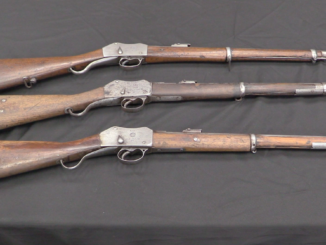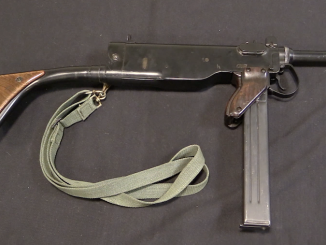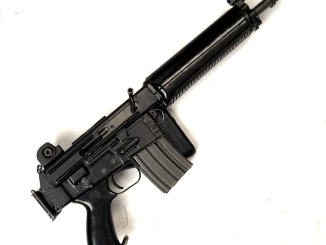Patented by one John Hall of Cumberland, England in 1902, this is a device intended to scare birds out of a field at regular intervals. It has twelve chambers for 12-gauge pinfire shotgun shells, which are fired by falling steel weights. Those weights are held up by thin cotton strings which are connected to the face of a clock dial inside the box. The hour hand on the clock has a small razor edge on it, which will cut the strings when the hand reaches them. Once the string is cut, the weight falls and fires a shell. The clock face has slots at 15-minute intervals, so one can select exactly when one wants each shell fired, up to the maximum capacity of 12 shells and the maximum time period of 12 hours. Neat!
You can see Hall’s patent here: https://worldwide.espacenet.com/publicationDetails/originalDocument?CC=GB&NR=190207756A&KC=A&FT=D&ND=3&date=19021204&DB=&locale=en_EP




” Neat!”
My first though after reading description was steam-punk.
And it reminded me about Vienna pneumatic-controlled street clocks, see drawings here: http://www.douglas-self.com/MUSEUM/COMMS/airclock/airclock.htm
Wait, wrong link: http://www.douglas-self.com/MUSEUM/COMMS/vienclock/vienclock.htm
With the addition of a tray holding some bird seed one could collect dinner as well.
The question is now which birds are edible. The extra question is whether you also shot some opportunistic squirrels along with the birds.
All birds are edible. The small ones may be not worth the effort, but there’s little to prevent you from eating one that has been properly prepared.:D
“All birds are edible.”
Most yes but not all. No bird was found to be able to produce own toxins, but some are able to ingest food with substance lethal to humans.
http://mentalfloss.com/article/51743/4-poisonous-birds
One of them is Coturnix coturnix,
12 gauge pinfire blanks? At everyone’s local hardware store I’m sure.
I suspect Hall was hoping to do a sideline in proprietary ammunition for these.
Unless brass pinfire shells were actually reloadable. I’ve always read that getting a new primer into a pinfire cartridge wasn’t practical. But with something as roomy as 12 gauge, maybe it would’ve been practical.
“Unless brass pinfire shells were actually reloadable”
In our times exist such device as Reloading kit for pinfire cartridge
http://www.hlebooks.com/pinfire/pin00.htm
I don’t know if such were available in 1902, but I would say such kit could be crafted with 1902 technology.
“12 gauge”
Considering samples collected by municion: http://municion.org/lefaucheux/12Gauge.htm
12 gauge pin-fire was common, also keep in mind pin-fire in general was more popular than today.
I knew this must be English (rather than British) before I even clicked the link! The cost of this Heath Robinson contraption, added to the cost of the man you paid to put in new string every single (f’ing) day, or even the cost in your own time to do it yourself, would surely have made it cheaper to pay some young lad to let off a shotgun every hour. There were young children being paid to scare birds of the sown fields with stones a few year’s before this was patented, and possibly when this was offered for sale! Of course, if you’d rather trust a complicated machine than some human less rich than you, then you deserved to lose your money to John Hall and his Fanny Farting Arse Blaster!
The fact that enough idiots bought this monstrosity to have it show up in American auctions shows that suckers have been born more than once a minute for many, many years.
“fact that enough idiots bought this monstrosity to have it show up in American auctions shows that suckers have been born more than once a minute for many, many years.”
Well, it seems that they might believe that:
If you are asking for price, then you can not afford it
” this Heath Robinson contraption”
For me, it is effect of then popular fascination for mechanical devices and just exploring possibilities of machines doing action, so you do not have to.
This reminded me about another device: https://en.wikipedia.org/wiki/Sundial_cannon
although it was much simpler and made rather to fire once at give hour rather than fire multiple times with given interval.
The sundial gun’s purpose was quite simple; it automated the custom of “firing the noon gun”.
Unless of course it was set to fire around fourish. Sun’s over the yardarm, cocktails all around!
cheers
eon
Oddly enough, propane-fueled “bird cannons” are still a thing and are for sale thru various vendors. They work for deer, too.
The most useful deterrents are fake plastic owls and a recording of an owl’s call that repeats now and then.
Birds may have small brains but they have very good memory functions.
cheers
eon
Similar in time (around 1902) patent for Bird Chaser:
https://patents.google.com/patent/US733778A
by Heinrich F Weber, citing
It is a well-known fact that dummy figures or scarecrows are not very effective in chasing birds away from orchards, cultivated fields, due, as the birds soon get accustomed to the figure and are not kept away by the same. It is different, however, when a body is used that is kept in motion and which makes some noise at the same time. So it requires the combination of motion and noise to drive away the birds and protect thereby fruittrees, cultivated fields, &c., against harm done by picking and consequent injuring the same by birds.
Other patents:
J.B.DAVEGGIO ORHCARD GUARD US333611A (1886)
A.C.DAVIS SCARECROW US697072A (1902) – also creating light blinks
E.FARNAM SCARECROW US1329044A (1919) – fake bird (see drawing)